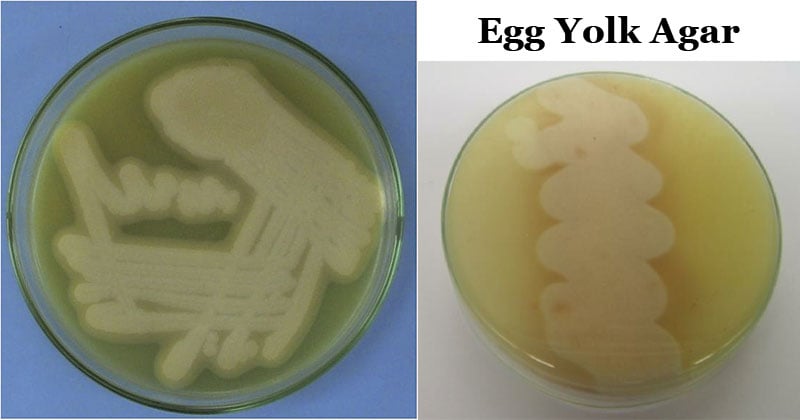Egg Yolk Agar, modified is based on the original formula for Egg Yolk Agar developed by McClung and Toabe for the isolation and differentiation of organisms based on Lecithinase and lipase production and proteolytic activity.

Image Source: Noura El-Ahmady El-Naggar, DOI: 10.5897/AJMR11.346
Interesting Science Videos
Composition of Egg Yolk Agar
| Ingredients | Gms/liter |
| Casein enzymic hydrolysate | 15.000 |
| Papaic digest of soybean meal | 5.000 |
| Yeast extract | 5.000 |
| Sodium chloride | 5.000 |
| L-Cystine | 0.400 |
| Hemin | 0.005 |
| Vitamin K1 | 0.010 |
| Agar | 20.000 |
Final pH (at 25°C): 7.5±0.2
Principle of Egg Yolk Agar
- Casein enzymic hydrolysate and Papaic digest of soyabean meal provide the essential nutrients along with carbonaceous and nitrogenous substances.
- Yeast extract supplies B-complex nutrients.
- Sodium chloride maintains the osmotic equilibrium.
- L-cystine is an amino acid which also acts as a reducing agent.
- Vitamin K1 and hemin help to enhance the growth of anaerobic organisms.
- Microorganisms that possess the enzyme lecithinase break down lecithin to insoluble diglyceride and phosphorylcholine, which results in a white opaque zone of precipitation that spreads beyond the edge of the colony.
- Microorganisms that possess the enzyme lipase hydrolyze the free fats present in the medium to form glycerol and free fatty acids.
- Consequently, the release of insoluble free fatty acids results in the formation of an iridescent sheen (oil on water) that can be seen when the plate is held at an angle to a light source.
- As compared to lecithinase, lipase is not diffusible and produces a reaction only on the surface of the agar in the immediate vicinity of the colony.
- Proteolysis is noted by the development of clear zones in the medium surrounding colony growth.
Preparation and Method of Use of Egg Yolk Agar
- Suspend 50.41 grams in 900 ml distilled water.
- Heat to boiling to dissolve the medium completely.
- Sterilize by autoclaving at 15 lbs pressure (121°C) for 15 minutes.
- Cool to 50-55°C and aseptically add 100 ml Egg Yolk Emulsion (or add 10 ml of sterile egg yolk emulsion per 90 ml of medium).
- Mix well and pour into sterile Petri plates.
- Prior to inoculation, allow medium to equilibrate to room temperature.
- If the medium is not already pre-reduced, it must be reduced by placing it under anaerobic conditions for 18-24 hours.
- Inoculate Egg Yolk Agar, Modified with a pure 24-72 hour culture. Streak the medium so as to obtain isolated colonies.
- Immediately following inoculation, place the medium, in an inverted position (agar side up), in an anaerobic atmosphere and incubate at 35-37ºC. for 48-72 hours.
- Observe plates for the appearance of lecithinase and lipase production and proteolytic activity after 48 hours of incubation. Cultures should not be discarded as negative until after 7 days of incubation.
Result Interpretation of Egg Yolk Agar
| Organisms | Growth |
| Clostridium perfringens | Growth; lecithinase positive; white, opaque zone extending from the edge of colonies, lipase negative; no sheen |
| Clostridium sporogenes | Growth; lecithinase negative; lipase positive; an iridescent sheen on agar surface when the plate is held at an angle to the light source |
| Bacteroides fragilis | Growth; lecithinase and lipase negative; no reaction on agar |
| Fusobacterium necrophorum | Good-luxuriant growth; negative reaction for lecithinase; positive for lipase reaction iridescent sheen on the colony surface and medium; no proteolytic activity no clear zone surrounding colonies |
Uses of Egg Yolk Agar
- It is an enriched, non-selective, and differential medium recommended for use in the detection of lecithinase and lipase production and proteolytic activity of certain obligate anaerobes.
- It is used for the presumptive identification of various Clostridium, Fusobacterium, and Prevotella
- It is also used in the Nagler Test for the presumptive identification of Clostridium perfringens.
Limitations of Egg Yolk Agar
- It is recommended that biochemical, immunological, molecular, or mass spectrometry testing be performed on colonies from pure culture for complete identification.
- The medium does not provide complete information for the identification of bacterial isolates. Additional biochemical and/or serological tests must be performed on colonies from pure culture for complete identification.
- A negative lecithinase test should be compared to an uninoculated control plate, as lecithinase can diffuse throughout the entire agar plate and make interpretation difficult.
- Some microorganisms may require up to one week to produce a positive lipase reaction.
- An enrichment broth should be simultaneously inoculated with the test sample to detect the small number of anaerobic organisms.
References
- http://himedialabs.com/TD/M1043.pdf
- http://legacy.bd.com/ds/technicalCenter/inserts/8806621(03).pdf
- https://assets.fishersci.com/TFS-Assets/LSG/manuals/IFU1056.pdf
- Noura El-Ahmady El-Naggar, A. A. Sherief and Sarah Shawky Hamza. Streptomyces aegyptia NEAE 102, a novel cellulolytic streptomycete isolated from soil in Egypt. African Journal of Microbiology Research Vol. 5(29), pp. 5308-5315, 9 December, 2011.

Description of solidifying agents in culturemedia otherthan agar&gelatin